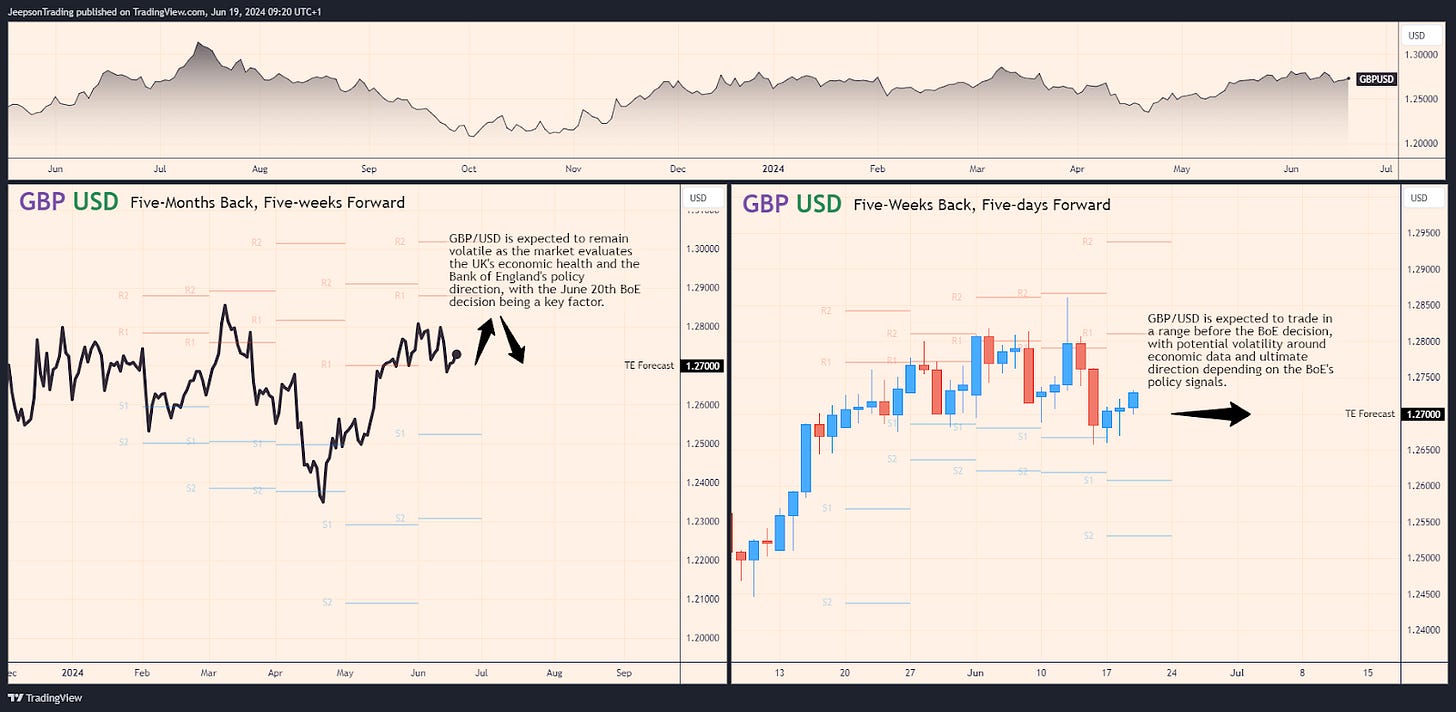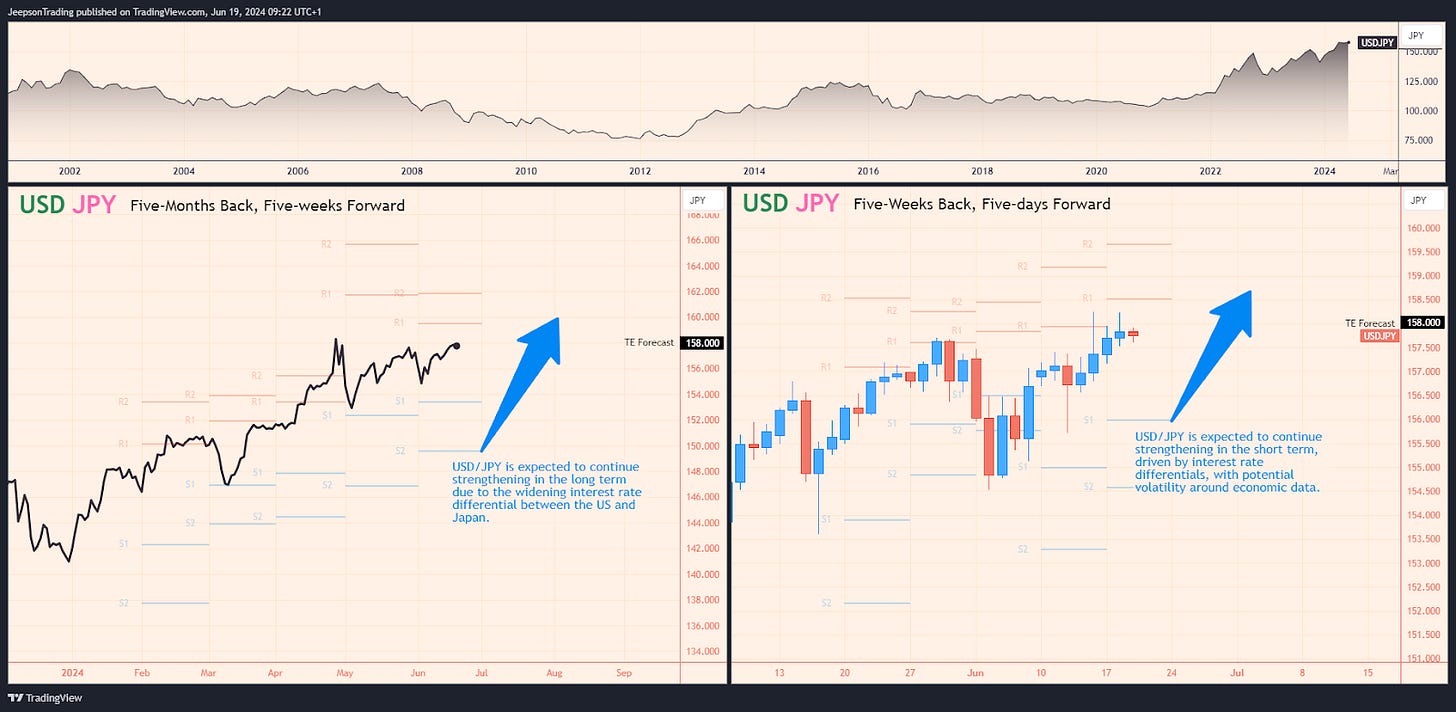Inflation Relief Rally Fades, Forex Traders Seek Direction From Economic Data and Central Banks
Wednesday, 19 June, Week 25: This report provides a concise analysis of the Forex market, focusing on EUR/USD, GBP/USD, and USD/JPY. Each section includes short and long-term outlooks, highlighting key economic indicators, risk events, and geopolitical themes that could impact trading decisions.
EUR/USD
EUR/USD has been on a downward trend for the past five weeks, falling from around 1.095 to 1.074. This weakness is primarily attributed to the strengthening US dollar and political uncertainty in France.
Long-term (five-weeks) outlook: A victory for pro-EU parties in the French parliamentary elections could support the euro, while a strong US economy and hawkish Fed could lead to further EUR/USD weakness.
The most likely long-term outlook for EUR/USD is for continued weakness. The US dollar remains supported by the Fed's hawkish stance and safe-haven demand amid geopolitical risks. The French elections pose a significant risk event, with the potential to exacerbate EUR weakness if the far-right National Rally performs well. Trading Economics forecasts EUR/USD at 1.08094 by the end of this quarter, suggesting a slight rebound, but political risks in France could lead to further downside.
Short-term (five-days) outlook: Weaker-than-expected US economic data, particularly the June 20th US Current Account and June 21st Flash PMIs, could soften the US dollar and support EUR/USD. Positive developments in the French political landscape could also provide a boost. Conversely, strong US data or negative French political news could pressure the pair.
The most likely short-term outlook for EUR/USD is for range-bound trading ahead of the French elections. The pair could see volatility around key economic data releases, but the overall direction hinges on the French political situation. Trading Economics' forecast of 1.08094 suggests a slight rebound, but the short-term outlook remains uncertain.
June 20 (Thursday): US Current Account (Q1), EU Consumer Confidence Flash (June)
June 21 (Friday): French, German, and Eurozone Flash PMIs (June)
GBP/USD
GBP/USD has been volatile over the past five weeks, initially strengthening to 1.286 before falling back to 1.271. This reflects uncertainty surrounding the UK's economic outlook and the upcoming BoE interest rate decision.
Long-term (five-weeks) outlook: A hawkish BoE, signalling further rate hikes, and strong UK economic data could support the pound. Conversely, a dovish BoE or weak UK data could weigh on GBP/USD.
The most likely long-term outlook for GBP/USD is for continued volatility as the market assesses the UK's economic outlook and the BoE's policy intentions. The June 20th BoE decision will be pivotal. Trading Economics forecasts GBP/USD at 1.26961 by the end of this quarter, suggesting a slight decline, but the outlook remains uncertain.
Short-term (five-days) outlook: Hawkish comments from BoE officials ahead of the June 20th meeting and stronger-than-expected UK economic data, particularly the June 21st Retail Sales and Flash PMIs, could support the pound. Dovish comments or weak data could pressure GBP/USD.
The most likely short-term outlook for GBP/USD is for range-bound trading ahead of the BoE decision. The pair could see volatility around key economic data releases, but the BoE's policy signals will likely determine the overall direction. Trading Economics' forecast of 1.26961 suggests a slight decline, but the short-term outlook remains uncertain.
June 20 (Thursday): Bank of England Interest Rate Decision, UK Initial Jobless Claims (w/e June 15th), UK Philly Fed Business Index (June)
June 21 (Friday): UK Retail Sales (May), UK Flash PMIs (June)
USD/JPY
USD/JPY has been on a strong uptrend for the past five weeks, rising from around 153 to 157.828. This is driven by the widening interest rate differential between the US and Japan, and safe-haven demand for the US dollar.
Long-term (five-weeks) outlook: A continued hawkish Fed and strong US economic data could further boost USD/JPY. The BoJ's commitment to ultra-loose monetary policy suggests further upside potential.
The most likely long-term outlook for USD/JPY is for continued strength. The interest rate differential between the US and Japan is expected to remain wide, suggesting further upside potential. Trading Economics forecasts USD/JPY at 157.995 by the end of this quarter, aligning with the view of continued strength.
Short-term (five-days) outlook: Hawkish comments from Fed officials and stronger-than-expected US economic data, particularly the June 20th US Current Account, could boost USD/JPY. Dovish comments or weak data could pressure the pair.
The most likely short-term outlook for USD/JPY is for continued strength, driven by the interest rate differential. The pair could see volatility around key economic data releases, but the overall trend is likely to remain upward. Trading Economics' forecast of 157.995 aligns with this view.
June 20 (Thursday): Bank of Japan Monetary Policy Meeting Minutes, US Current Account (Q1)
June 21 (Friday): Japanese Flash PMIs (June)
Geopolitics and Market Themes
Israel-Hamas Conflict
Synopsis: The conflict is contributing to risk aversion, supporting the US dollar and weighing on the yen and euro.
Key Developments:
Israel announced a daily tactical pause in operations near a crossing into Gaza for humanitarian purposes.
Hamas leader Ismail Haniyeh stated that the group's response to the latest Gaza ceasefire proposal aligns with the principles of US President Joe Biden's plan.
Hezbollah launched rockets into northern Israel in retaliation for the killing of a senior commander by Israel.
The White House announced that Qatar and Egypt plan to hold talks with Hamas regarding a Gaza ceasefire.
Market Impact:
Flight to safety, boosting the US dollar and weighing on the yen and euro.
Concerns about oil supply disruptions support oil prices, potentially negatively impacting the Japanese economy.
Political Uncertainty in Europe
Synopsis: Political instability in Europe, particularly in France, is weighing on investor sentiment and the euro, indirectly supporting the US dollar and pressuring the yen.
Key Developments:
French President Emmanuel Macron dissolved the government following the National Rally's strong performance in the EU parliamentary elections.
Concerns about uncontrolled spending and fiscal imbalances in France have arisen due to the prospect of a parliamentary swing to the National Rally.
Market Impact:
The euro has depreciated against the US dollar, reflecting heightened uncertainty in the Eurozone.
Euro weakness indirectly supports the US dollar, putting further pressure on the yen.
Global Inflation and Monetary Policy Divergence
Synopsis: Inflation remains a global concern, but recent data suggests easing in some economies. The divergence in monetary policy between the Fed and other central banks is creating currency market volatility.
Key Developments:
The Fed held rates steady but signalled a cautious approach to rate cuts, projecting only one reduction this year.
The ECB cut rates by 25bps, shifting from its previous stance.
The BoJ maintained its ultra-loose monetary policy.
Market Impact:
The US dollar has strengthened as the Fed's hawkish stance contrasts with easing policies elsewhere.
US Treasury yields have fallen as investors anticipate potential rate cuts.
The Japanese yen has weakened to multi-decade lows against the dollar, reflecting the monetary policy divergence.
OTHER NEWS
China's Securities Regulator to Enrich Policy Tools to Manage Market Fluctuations: The regulator aims to prevent abnormal stock market volatility, potentially impacting Chinese equities and the yuan.
Senior US Official to Visit Japan and Netherlands to Discuss Semiconductor Restrictions on China: This could escalate US-China tensions, impacting trade and technology sectors.
US House of Representatives Launches Bipartisan Critical Minerals Working Group: This highlights the focus on securing critical mineral supply chains, potentially impacting commodity markets.
Conclusion
The Forex market is influenced by geopolitical risks, European political uncertainty, and diverging monetary policies. The US dollar remains strong, while the euro faces headwinds. The Japanese yen continues to weaken against the dollar.
Traders should monitor the French elections, the BoE's June 20th announcement, and the BoJ's July meeting. Economic data, central bank communications, and geopolitical developments will be crucial for determining currency pair directions.
References
Federal Reserve: https://www.federalreserve.gov/
European Central Bank: https://www.ecb.europa.eu/
Bank of England: https://www.bankofengland.co.uk/
Bank of Japan: https://www.boj.or.jp/en/
US Census Bureau: https://www.census.gov/
Bureau of Economic Analysis: https://www.bea.gov/
Eurostat: https://ec.europa.eu/eurostat/
Office for National Statistics: https://www.ons.gov.uk/
Trading Economics: https://tradingeconomics.com/
Bloomberg: https://www.bloomberg.com/
Reuters: https://www.reuters.com/
Financial Times: https://www.ft.com/
Cabinet Office, Japan: https://www8.cao.go.jp/
Ministry of Finance - Japan: https://www.mof.go.jp/english





